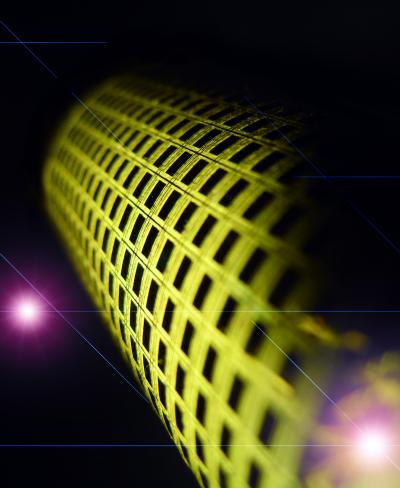Nanowire Matrix Skin for Robots, Artificial Limbs, (and Architecture?)
Image courtesy blogs.theage.com.au
Sometimes human beings lose body parts through unfortunate accidents, and are fitted with prosthetic limbs. These limbs look like typical arms and legs (unless they don’t) but they can’t respond in as nuanced a manner as arms and legs with skin on them.Recently, scientists at the University of California at Berkeley have made advances in the creation of artificial skin, a material that goes a long way towards “replacing today’s clumsy robots and artificial arms with smarter, touch-sensitive upgrades… The “e-skin” … comprises a matrix of nanowires made of germanium and silicon rolled onto a sticky polyimide film” (Ingham). On top of the wires, the researchers laid nano-scale transistors and a pressure-sensitive flexible rubber material. The assembly can detect pressures comparable to the force required to type on a computer keyboard or to hold an egg.
Credit: Ali Javey and Kuniharu Takei
At nearby Stanford University, a Chinese-born associate professor who has gained a reputation as one of the top women chemists in the United States named Zhenan Bao is leading a team working on artificial skin. “Their approach was to use a rubber film that changes thickness due to pressure, and employs capacitors, integrated into the material, to measure the difference” (Ingham). While the response time is within milliseconds, meaning that pressure can be detected almost instantaneously, the material cannot be stretched. The ability to stretch is an important characteristic of non-artificial skin, and I’m sure they’re going to work on it.
Credit: Ali Javey and Kuniharu Takei, UC Berkeley
Both teams have achieved significant milestones in the field of artificial intelligence, and it’s especially exciting because they’re working with low-cost processing components. Future artificial skin might be embedded with sensors that respond to chemicals, biological agents, temperature, humidity, radioactivity or pollutants (Ingham). Bao and her team envision a prototype in the form of a handheld device, or one that can connect “to other parts of the body that have skin sensation. The device would generate a pulse that would stimulate other parts of the skin, giving the kind of signal ‘my (artificial) hand is touching something’, for instance” (Ingham). Maybe eventually the skin could also have its own iPhone app.
There is, as always, room for improvement; the current sensors respond to constant pressure, whereas human skin can send different signal frequencies (for example, if something feels painful or sharp like a knife or sword, frequency increases to alert us to the threat). Not only that, it will be massively challenging to connect any artificial skin to a human nervous system in order to restore sensation (Ingham).
This innovation has architectural implications as well, as I see it. Imagine a wall or even an entire building coated with artificial skin, allowing it to respond to pressure and temperature changes by deforming or giving off heat or changing color or something. Hmmm. I smell a project… maybe I’ll have something to add to the LAB page, which has lain dormant since the dawn of ARCHITERIALS…
I’m filing artificial skin under both fire and plastic – because it involves a complex interaction between electrical impulses and thin, flexible substrate and surface layers. BAM!
Cited:
Ingham, Richard. “Robotics Breakthrough: Scientists make Artificial Skin” Physorg.com 09/12/10. Accessed 09/15/10. URL.



















Nanowire skin matrix is very useful in particularly going to the outer space and go further places,I suppose.
Leave a Wordpress Comment: